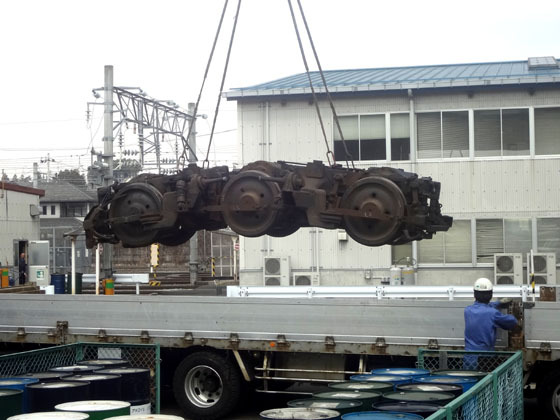DE10 Locomotive – Co-Bo or AAA-B?
Any idea what I'm talking about? It's the wheel arrangements of diesel/electric locomotives. As per the old steamers (Whyte Notation) and their arrangements of 2-6-4 or 4-8-4+4-8-4, more modern locomotives use a similar nomenclature known as the UIC classification.
The basic idea is that, per bogie, a letter starting from A is assigned, determined by the amount of wheelsets; where a wheelset is 2 wheels plus an axle. The letter is incremented from A for each wheelset. A bogie with two wheelsets will be defined as a Bo, 3 wheelsets means a Co.
You'll notice I put the letter 'o' after the B and C above. This is because, on some locomotives, the wheelsets can be mounted on the frame. The 'o' indicates that the wheelset is mounted on an attached bogie. I was about to write that I hadn't officially seen an 'Ao' yet; wouldn't the bogie spin on the wrong axis and derail? It turns out that it wont if you mount it correctly. The Japanese DD54 (wikipedia.jp) is of class Bo-1-Bo. I do note that it's not an 'Ao'... but it is indeed a bogie with only one axle!
As above, not all wheelsets are mounted on bogies, and not all wheelsets have power attached, so you'll need to read the wiki link on UIC classifications to really get the full picture.
Japanese wheel arrangements
My favourite Japanese electric, the EF-66 as seen below, is a Bo-Bo-Bo.
This majestic piece of equipment therefore has three bogies with two driven wheelsets each. The Japanese fashion is to have traction motors strapped onto each axle in parallel.
An now, the DE10
This is one of the more light-weight, shunting-type locomotives used around yards in Japan or for shorter freight movements. It's seen below at Aomori, ready to pull the passenger consist of the Nihonkai that I travelled on away from the EF81 that was ready for a snooze.
I recently acquired a Micro-Ace model of one in the Watarase Railway colours. Gold and Maroon is really quite fetching over the standard Red/Grey/White/Black.
Anyway, back to the point, I was reading the back and saw that the 'real world' technical specifications indicated that the wheel arrangement was infact AAA-B (where that B can be translated to a 'Bo'.) I was expecting Co-Bo... not AAA. What gives? It turns out that, for tractive effort and weight distribution, the front bogie is actually articulated! So they've classified it as three mini-bogies of one driven axle each.
I then recalled seeing mentionings of this on the JNS Forum posts here [DE10 - What does it haul?] and here [More tech questions re Class DD51 and DE10 diesels]. The latter links to a blog post titled 【仙貨へGO!】この足は誰のもの?仙貨に搬入されたDE10の台車たち from a Japanese enthusiast by the name of 歩王(あるきんぐ) (Arukingu). 仙貨 (Sen-kamo) is actually an abbreviation of Sendai Kamotsu, the freight yard in Sendai. Do not get this confused with Sendai Transport, a comedic rock band! The title of the blog post loosely translates to: "[Let's go to Sendai Freight Yard] Who's wheels/legs are these? Lifting a DE10 Locomotive." Here's the main picture you really need to see:



 Melbourne BG SCS Train Timetable
Melbourne BG SCS Train Timetable 




April 20th, 2019 - 05:38
Hello stevenh,
I’m not sure weather you will follow this thread after so many years. I was brought to your lines by the very same research – which wheel notation is correct for JFR DE10/DE11/DE15.
First you should go back an read over UIC notation again. The small “o” indicates individual drive for each wheelset, thus a diesel hydraulic engine with one prime mover cannot carry any ‘o’, we can only discuss how wheelsets are supported in the main frame. C’ would be three wheelsets in one bogie, AAA would be three individual wheelsets directly attached to the main frame. What I see on the picture appears what is mostly considered one bogie with three driven wheelsets, thus C’.
AAA most likely comes from the idea that each wheelset is supported by an individual frame or bogie within the main bogie. This is what you find with quite a few six-wheel bogies and ist usually simplified to C’ (or Co’ with individual driving engines) – most correctly we would have to call this something like this (AAA)’ or even (A’AA’)’ with ‘ indicating the subframe.
I hope this helps any further confusion… Just get back to me via email if it still puzzles you, the rest of the world will likely stay with C’B’ or just leave this question to the japanese hobbyists.
Regars
/Dennis